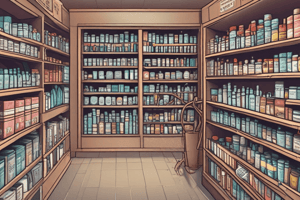Podcast
Questions and Answers
How should Schedule I, II, III, and IV controlled substances be stored?
How should Schedule I, II, III, and IV controlled substances be stored?
- In a securely locked drawer
- In a single locked cabinet
- On an open shelf
- In a stationary, locked double cabinet with separate keys (correct)
What is the minimum storage requirement for controlled substances prescribed for a specific patient in quantities exceeding a 72-hour supply?
What is the minimum storage requirement for controlled substances prescribed for a specific patient in quantities exceeding a 72-hour supply?
- Securely locked cabinet (correct)
- Locked medication cart
- Anchored storage unit
- Open shelf
What type of lock is not acceptable for storing Schedule I, II, III, and IV controlled substances?
What type of lock is not acceptable for storing Schedule I, II, III, and IV controlled substances?
- Double-keyed locks
- Combination dial locks (correct)
- Spring locks (correct)
- Key-locked doors
Where can controlled substances prescribed for a specific patient in quantities not exceeding a 72-hour supply be stored?
Where can controlled substances prescribed for a specific patient in quantities not exceeding a 72-hour supply be stored?
What is a requirement for medication carts storing Schedule III, IV, and V controlled substances?
What is a requirement for medication carts storing Schedule III, IV, and V controlled substances?
Why should access to medication carts be limited to an identified individual at all times?
Why should access to medication carts be limited to an identified individual at all times?
What type of construction is recommended for new cabinets storing controlled substances?
What type of construction is recommended for new cabinets storing controlled substances?
What is an exception to the general storage requirements for controlled substances?
What is an exception to the general storage requirements for controlled substances?
What type of lock is required on the door of a GSA class 5 rated steel cabinet for storing Schedule I and II controlled substances?
What type of lock is required on the door of a GSA class 5 rated steel cabinet for storing Schedule I and II controlled substances?
How must a cabinet or safe weighing less than 750 pounds be secured?
How must a cabinet or safe weighing less than 750 pounds be secured?
What is the minimum thickness of the steel plate required for the door of a cabinet or safe storing Schedule I and II controlled substances?
What is the minimum thickness of the steel plate required for the door of a cabinet or safe storing Schedule I and II controlled substances?
What is the minimum construction requirement for a vault storing Schedule I and II controlled substances?
What is the minimum construction requirement for a vault storing Schedule I and II controlled substances?
How may working stocks of controlled substances of a registered pharmacy be dispersed?
How may working stocks of controlled substances of a registered pharmacy be dispersed?
What is the requirement for storing Schedule III, IV and V controlled substances?
What is the requirement for storing Schedule III, IV and V controlled substances?
When must a registered pharmacy be locked?
When must a registered pharmacy be locked?
What type of controlled substances may be stored in a stationary, securely locked cabinet of substantial construction?
What type of controlled substances may be stored in a stationary, securely locked cabinet of substantial construction?
Flashcards are hidden until you start studying
Study Notes
Minimum Security Standards for Institutional Dispensers
- Institutional dispensers must securely store controlled substances according to their schedule:
- Schedule I and II controlled substances: stored in a GSA class 5 rated steel cabinet or equivalent safe approved by the Bureau of Narcotic Enforcement, or a vault with a multiple position combination lock, relocking device, and steel plate at least 0.5 inches thick.
- Schedule III, IV, and V controlled substances: stored in a securely locked cabinet of substantial construction.
Storage of Working Stocks
- Working stocks of controlled substances in a registered pharmacy:
- May be dispersed throughout non-controlled substances to obstruct theft or diversion, if the conditions of section 80.6 are met and the pharmacy is locked when not in operation.
- If not dispersed, controlled substances in Schedules II, III, and IV must be kept in a stationary, securely locked cabinet of substantial construction.
- Working stocks of controlled substances for institutional dispensers without a registered pharmacy, treatment programs, license holders engaging in research, instructional activities, and chemical analysis:
- Schedule I, II, III, and IV controlled substances: stored in stationary, locked double cabinets with separate keys for inner and outer cabinets.
- Schedule V controlled substances: stored in a stationary, securely locked cabinet of substantial construction.
- Limited supplies of controlled substances for emergency situations: stocked in sealed emergency medication kits.
Patient Care Units
- Patient care units of institutional dispensers or institutional dispensers limited:
- Controlled substances kept as floor stocks on patient care units for general patient use and quantities prescribed or ordered for a specific patient exceeding a 72-hour supply must be stored according to subdivision (c) of this section.
- Controlled substances prescribed or ordered for a specific patient in quantities not exceeding a 72-hour supply may be stored with the patient's other medications at the patient care unit, provided they are kept in a securely locked medication cart or other approved storage unit.
- Schedule II controlled substances may not be stocked in medication carts.
- Medication carts must be equipped with double-keyed locks, anchored to a floor or wall device, have a locked drawer system, and an independent locking device. Access to medication carts shall be limited to an identified individual at all times.
Studying That Suits You
Use AI to generate personalized quizzes and flashcards to suit your learning preferences.




